ECON 1002A - Macroeconomics: Analyzing Relationships with Output
VerifiedAdded on 2023/04/20
|9
|1278
|261
Homework Assignment
AI Summary
This assignment analyzes the relationship between macroeconomic variables and output growth using data from a selected country. It examines the correlation and volatility of consumption, investment, government spending, exports, and imports relative to real GDP. The analysis reveals that consumption, investment, exports, and imports are pro-cyclical, moving in the same direction as output, while government spending shows a weaker correlation. The assignment also highlights the relative volatility of each variable, with investment, exports, and imports being more volatile than output. The study uses statistical measures such as correlation coefficients and standard deviations to support its findings, providing a comprehensive overview of how these macroeconomic components interact with a nation's output.

Running head: MACROECONOMICS
Macroeconomics
Name of the Student
Name of the University
Course ID
Macroeconomics
Name of the Student
Name of the University
Course ID
Paraphrase This Document
Need a fresh take? Get an instant paraphrase of this document with our AI Paraphraser
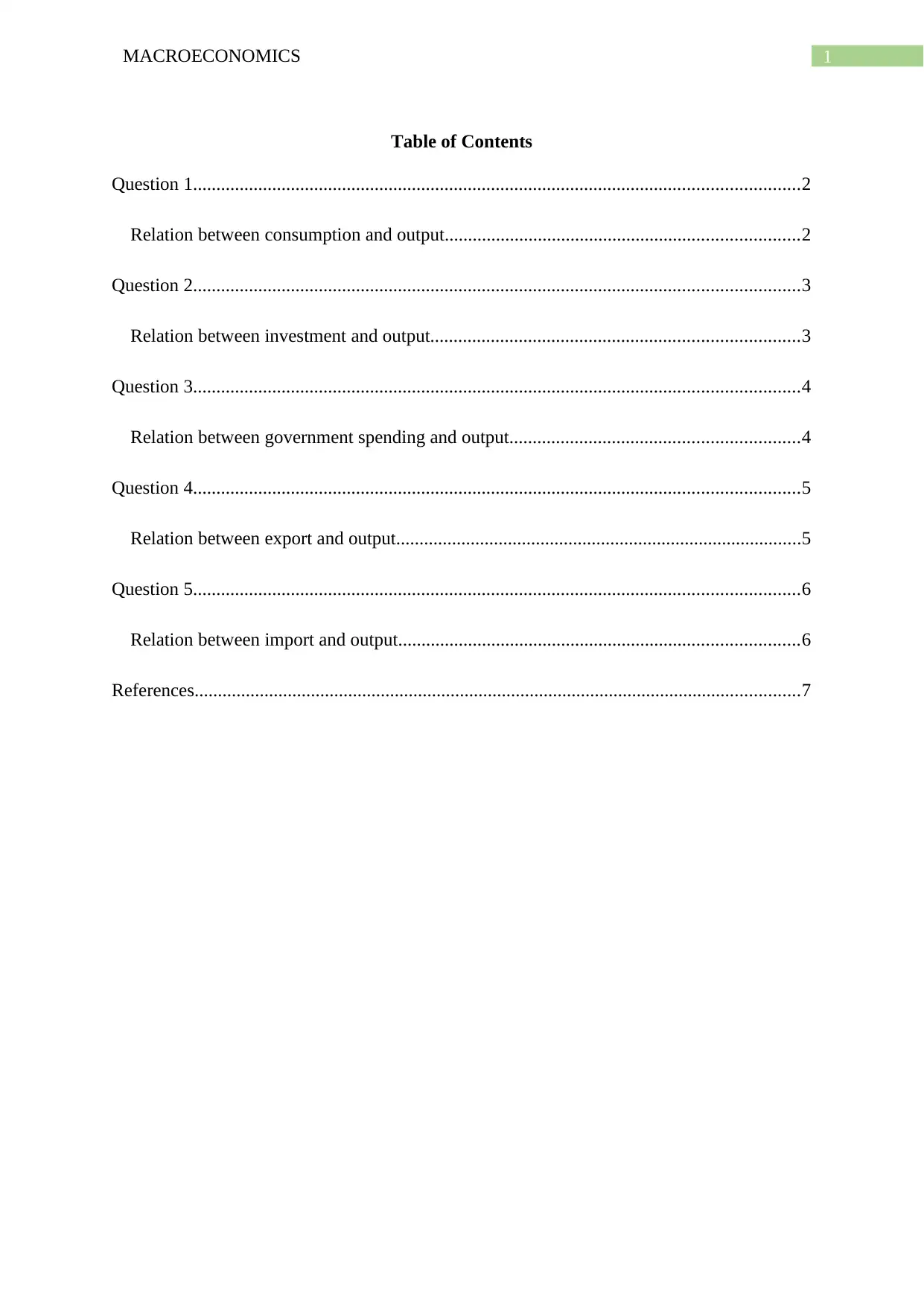
1MACROECONOMICS
Table of Contents
Question 1..................................................................................................................................2
Relation between consumption and output............................................................................2
Question 2..................................................................................................................................3
Relation between investment and output...............................................................................3
Question 3..................................................................................................................................4
Relation between government spending and output..............................................................4
Question 4..................................................................................................................................5
Relation between export and output.......................................................................................5
Question 5..................................................................................................................................6
Relation between import and output......................................................................................6
References..................................................................................................................................7
Table of Contents
Question 1..................................................................................................................................2
Relation between consumption and output............................................................................2
Question 2..................................................................................................................................3
Relation between investment and output...............................................................................3
Question 3..................................................................................................................................4
Relation between government spending and output..............................................................4
Question 4..................................................................................................................................5
Relation between export and output.......................................................................................5
Question 5..................................................................................................................................6
Relation between import and output......................................................................................6
References..................................................................................................................................7

2MACROECONOMICS
Table 1: Average growth rate and standard deviation for the selected variables
Variable Average
Standard
deviation
Real GDP
3.00018
4 2.23414973
Consumption
3.13993
9 1.90612462
Investment 3.41216 5.713050989
Government
spending
7.62559
1 6.848963433
Export
8.59983
1 9.966384066
Import
9.13409
5 10.00186903
Table 2: Correlation between Real GDP and other variables
Variable
Real
GDP
Consumption
0.85474
2
Investment 0.71782
Government
spending
0.09599
3
Export
0.65408
6
Import
0.72569
4
Question 1
Relation between consumption and output
Table 1: Average growth rate and standard deviation for the selected variables
Variable Average
Standard
deviation
Real GDP
3.00018
4 2.23414973
Consumption
3.13993
9 1.90612462
Investment 3.41216 5.713050989
Government
spending
7.62559
1 6.848963433
Export
8.59983
1 9.966384066
Import
9.13409
5 10.00186903
Table 2: Correlation between Real GDP and other variables
Variable
Real
GDP
Consumption
0.85474
2
Investment 0.71782
Government
spending
0.09599
3
Export
0.65408
6
Import
0.72569
4
Question 1
Relation between consumption and output
⊘ This is a preview!⊘
Do you want full access?
Subscribe today to unlock all pages.

Trusted by 1+ million students worldwide
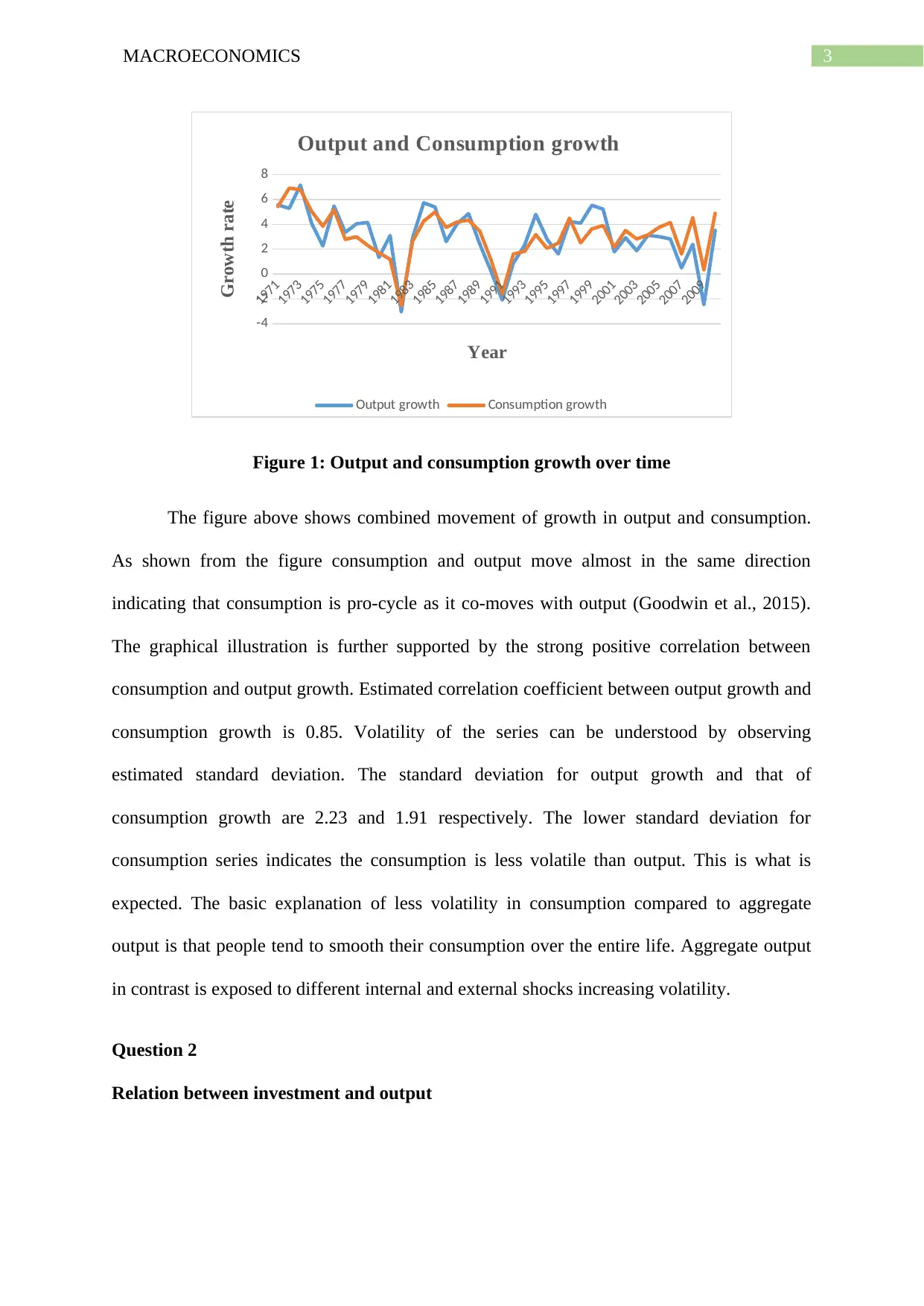
3MACROECONOMICS
1971
1973
1975
1977
1979
1981
1983
1985
1987
1989
1991
1993
1995
1997
1999
2001
2003
2005
2007
2009
-4
-2
0
2
4
6
8
Output and Consumption growth
Output growth Consumption growth
Year
Growth rate
Figure 1: Output and consumption growth over time
The figure above shows combined movement of growth in output and consumption.
As shown from the figure consumption and output move almost in the same direction
indicating that consumption is pro-cycle as it co-moves with output (Goodwin et al., 2015).
The graphical illustration is further supported by the strong positive correlation between
consumption and output growth. Estimated correlation coefficient between output growth and
consumption growth is 0.85. Volatility of the series can be understood by observing
estimated standard deviation. The standard deviation for output growth and that of
consumption growth are 2.23 and 1.91 respectively. The lower standard deviation for
consumption series indicates the consumption is less volatile than output. This is what is
expected. The basic explanation of less volatility in consumption compared to aggregate
output is that people tend to smooth their consumption over the entire life. Aggregate output
in contrast is exposed to different internal and external shocks increasing volatility.
Question 2
Relation between investment and output
1971
1973
1975
1977
1979
1981
1983
1985
1987
1989
1991
1993
1995
1997
1999
2001
2003
2005
2007
2009
-4
-2
0
2
4
6
8
Output and Consumption growth
Output growth Consumption growth
Year
Growth rate
Figure 1: Output and consumption growth over time
The figure above shows combined movement of growth in output and consumption.
As shown from the figure consumption and output move almost in the same direction
indicating that consumption is pro-cycle as it co-moves with output (Goodwin et al., 2015).
The graphical illustration is further supported by the strong positive correlation between
consumption and output growth. Estimated correlation coefficient between output growth and
consumption growth is 0.85. Volatility of the series can be understood by observing
estimated standard deviation. The standard deviation for output growth and that of
consumption growth are 2.23 and 1.91 respectively. The lower standard deviation for
consumption series indicates the consumption is less volatile than output. This is what is
expected. The basic explanation of less volatility in consumption compared to aggregate
output is that people tend to smooth their consumption over the entire life. Aggregate output
in contrast is exposed to different internal and external shocks increasing volatility.
Question 2
Relation between investment and output
Paraphrase This Document
Need a fresh take? Get an instant paraphrase of this document with our AI Paraphraser
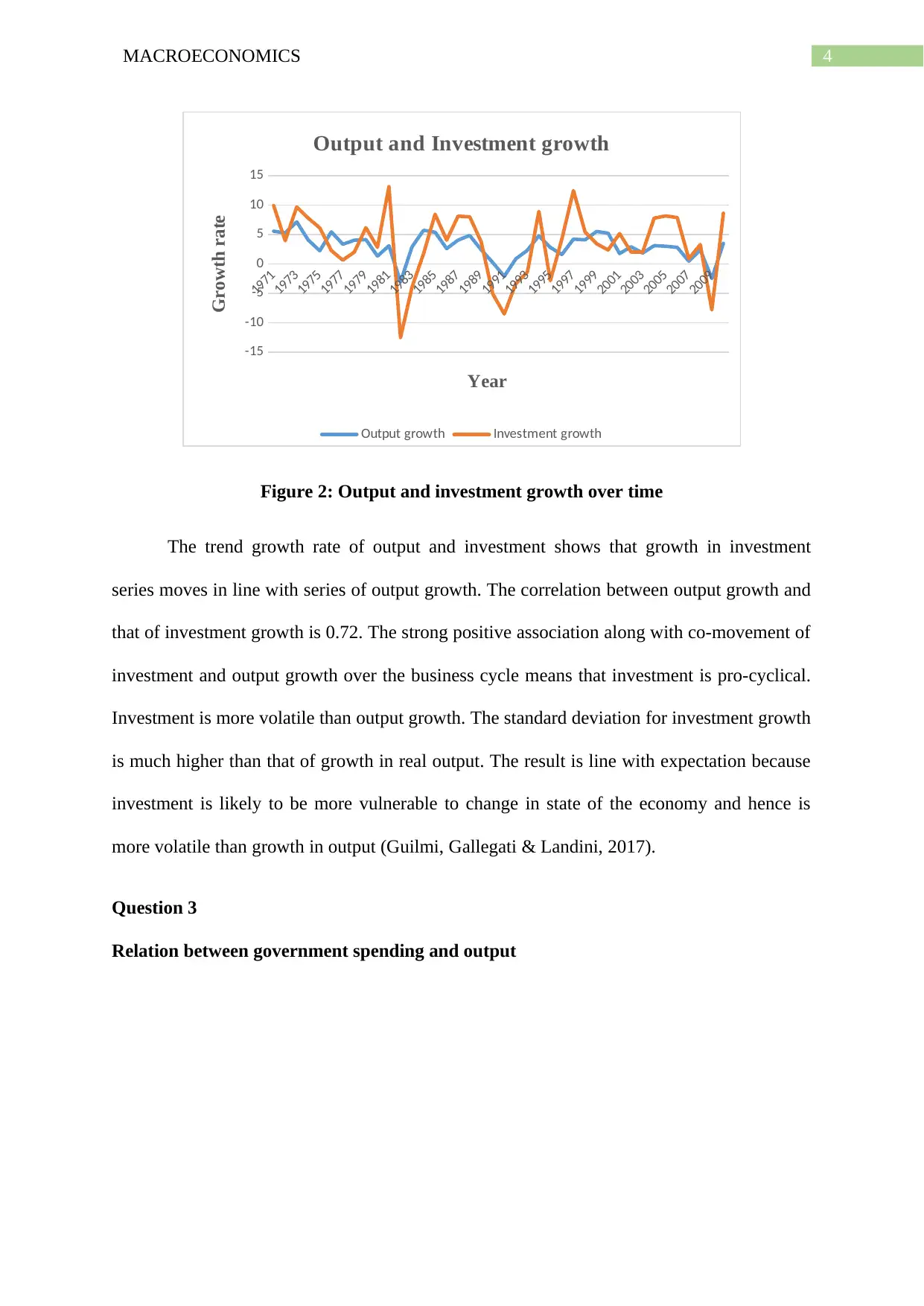
4MACROECONOMICS
1971
1973
1975
1977
1979
1981
1983
1985
1987
1989
1991
1993
1995
1997
1999
2001
2003
2005
2007
2009
-15
-10
-5
0
5
10
15
Output and Investment growth
Output growth Investment growth
Year
Growth rate
Figure 2: Output and investment growth over time
The trend growth rate of output and investment shows that growth in investment
series moves in line with series of output growth. The correlation between output growth and
that of investment growth is 0.72. The strong positive association along with co-movement of
investment and output growth over the business cycle means that investment is pro-cyclical.
Investment is more volatile than output growth. The standard deviation for investment growth
is much higher than that of growth in real output. The result is line with expectation because
investment is likely to be more vulnerable to change in state of the economy and hence is
more volatile than growth in output (Guilmi, Gallegati & Landini, 2017).
Question 3
Relation between government spending and output
1971
1973
1975
1977
1979
1981
1983
1985
1987
1989
1991
1993
1995
1997
1999
2001
2003
2005
2007
2009
-15
-10
-5
0
5
10
15
Output and Investment growth
Output growth Investment growth
Year
Growth rate
Figure 2: Output and investment growth over time
The trend growth rate of output and investment shows that growth in investment
series moves in line with series of output growth. The correlation between output growth and
that of investment growth is 0.72. The strong positive association along with co-movement of
investment and output growth over the business cycle means that investment is pro-cyclical.
Investment is more volatile than output growth. The standard deviation for investment growth
is much higher than that of growth in real output. The result is line with expectation because
investment is likely to be more vulnerable to change in state of the economy and hence is
more volatile than growth in output (Guilmi, Gallegati & Landini, 2017).
Question 3
Relation between government spending and output
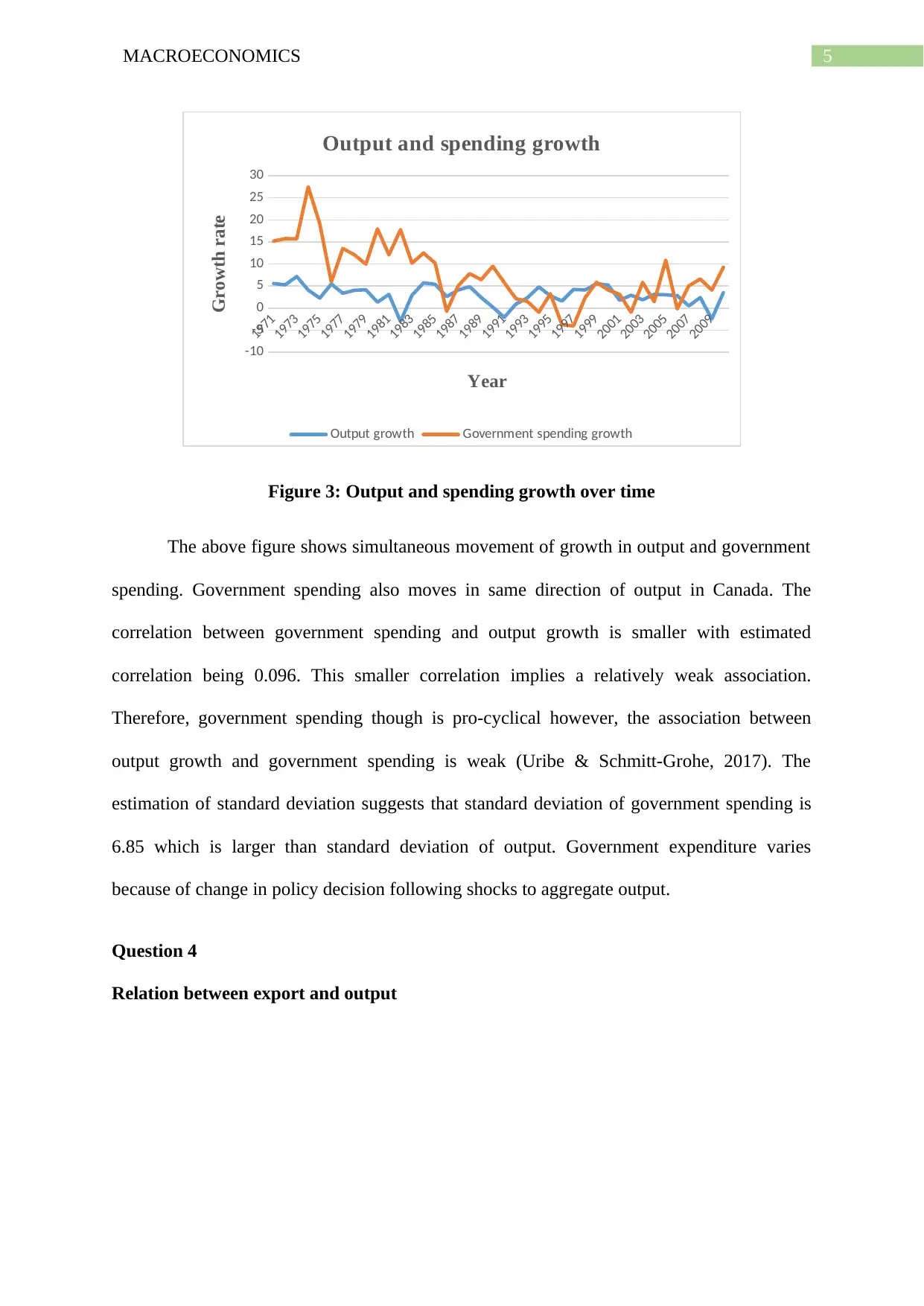
5MACROECONOMICS
1971
1973
1975
1977
1979
1981
1983
1985
1987
1989
1991
1993
1995
1997
1999
2001
2003
2005
2007
2009
-10
-5
0
5
10
15
20
25
30
Output and spending growth
Output growth Government spending growth
Year
Growth rate
Figure 3: Output and spending growth over time
The above figure shows simultaneous movement of growth in output and government
spending. Government spending also moves in same direction of output in Canada. The
correlation between government spending and output growth is smaller with estimated
correlation being 0.096. This smaller correlation implies a relatively weak association.
Therefore, government spending though is pro-cyclical however, the association between
output growth and government spending is weak (Uribe & Schmitt-Grohe, 2017). The
estimation of standard deviation suggests that standard deviation of government spending is
6.85 which is larger than standard deviation of output. Government expenditure varies
because of change in policy decision following shocks to aggregate output.
Question 4
Relation between export and output
1971
1973
1975
1977
1979
1981
1983
1985
1987
1989
1991
1993
1995
1997
1999
2001
2003
2005
2007
2009
-10
-5
0
5
10
15
20
25
30
Output and spending growth
Output growth Government spending growth
Year
Growth rate
Figure 3: Output and spending growth over time
The above figure shows simultaneous movement of growth in output and government
spending. Government spending also moves in same direction of output in Canada. The
correlation between government spending and output growth is smaller with estimated
correlation being 0.096. This smaller correlation implies a relatively weak association.
Therefore, government spending though is pro-cyclical however, the association between
output growth and government spending is weak (Uribe & Schmitt-Grohe, 2017). The
estimation of standard deviation suggests that standard deviation of government spending is
6.85 which is larger than standard deviation of output. Government expenditure varies
because of change in policy decision following shocks to aggregate output.
Question 4
Relation between export and output
⊘ This is a preview!⊘
Do you want full access?
Subscribe today to unlock all pages.

Trusted by 1+ million students worldwide
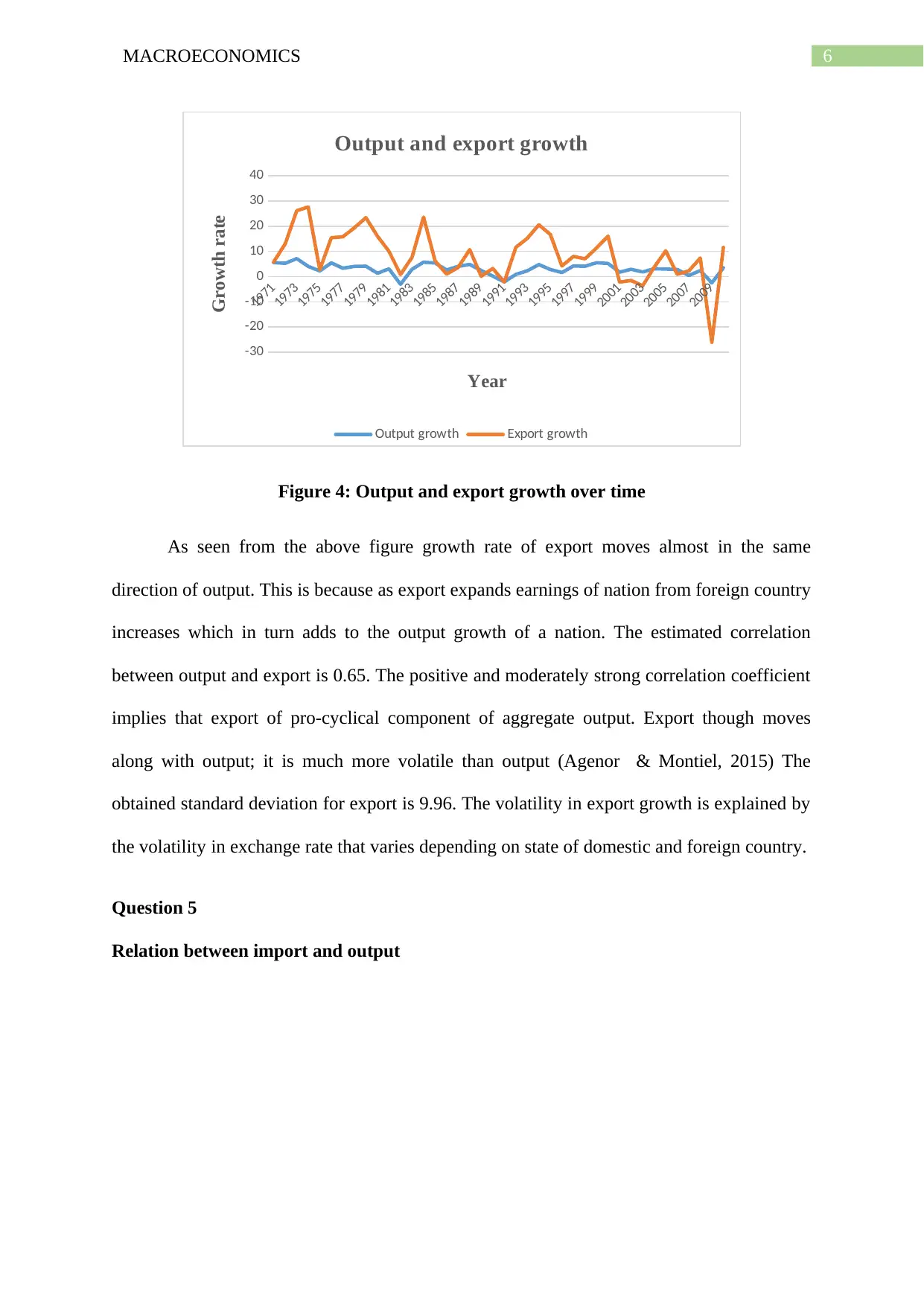
6MACROECONOMICS
1971
1973
1975
1977
1979
1981
1983
1985
1987
1989
1991
1993
1995
1997
1999
2001
2003
2005
2007
2009
-30
-20
-10
0
10
20
30
40
Output and export growth
Output growth Export growth
Year
Growth rate
Figure 4: Output and export growth over time
As seen from the above figure growth rate of export moves almost in the same
direction of output. This is because as export expands earnings of nation from foreign country
increases which in turn adds to the output growth of a nation. The estimated correlation
between output and export is 0.65. The positive and moderately strong correlation coefficient
implies that export of pro-cyclical component of aggregate output. Export though moves
along with output; it is much more volatile than output (Agenor & Montiel, 2015) The
obtained standard deviation for export is 9.96. The volatility in export growth is explained by
the volatility in exchange rate that varies depending on state of domestic and foreign country.
Question 5
Relation between import and output
1971
1973
1975
1977
1979
1981
1983
1985
1987
1989
1991
1993
1995
1997
1999
2001
2003
2005
2007
2009
-30
-20
-10
0
10
20
30
40
Output and export growth
Output growth Export growth
Year
Growth rate
Figure 4: Output and export growth over time
As seen from the above figure growth rate of export moves almost in the same
direction of output. This is because as export expands earnings of nation from foreign country
increases which in turn adds to the output growth of a nation. The estimated correlation
between output and export is 0.65. The positive and moderately strong correlation coefficient
implies that export of pro-cyclical component of aggregate output. Export though moves
along with output; it is much more volatile than output (Agenor & Montiel, 2015) The
obtained standard deviation for export is 9.96. The volatility in export growth is explained by
the volatility in exchange rate that varies depending on state of domestic and foreign country.
Question 5
Relation between import and output
Paraphrase This Document
Need a fresh take? Get an instant paraphrase of this document with our AI Paraphraser
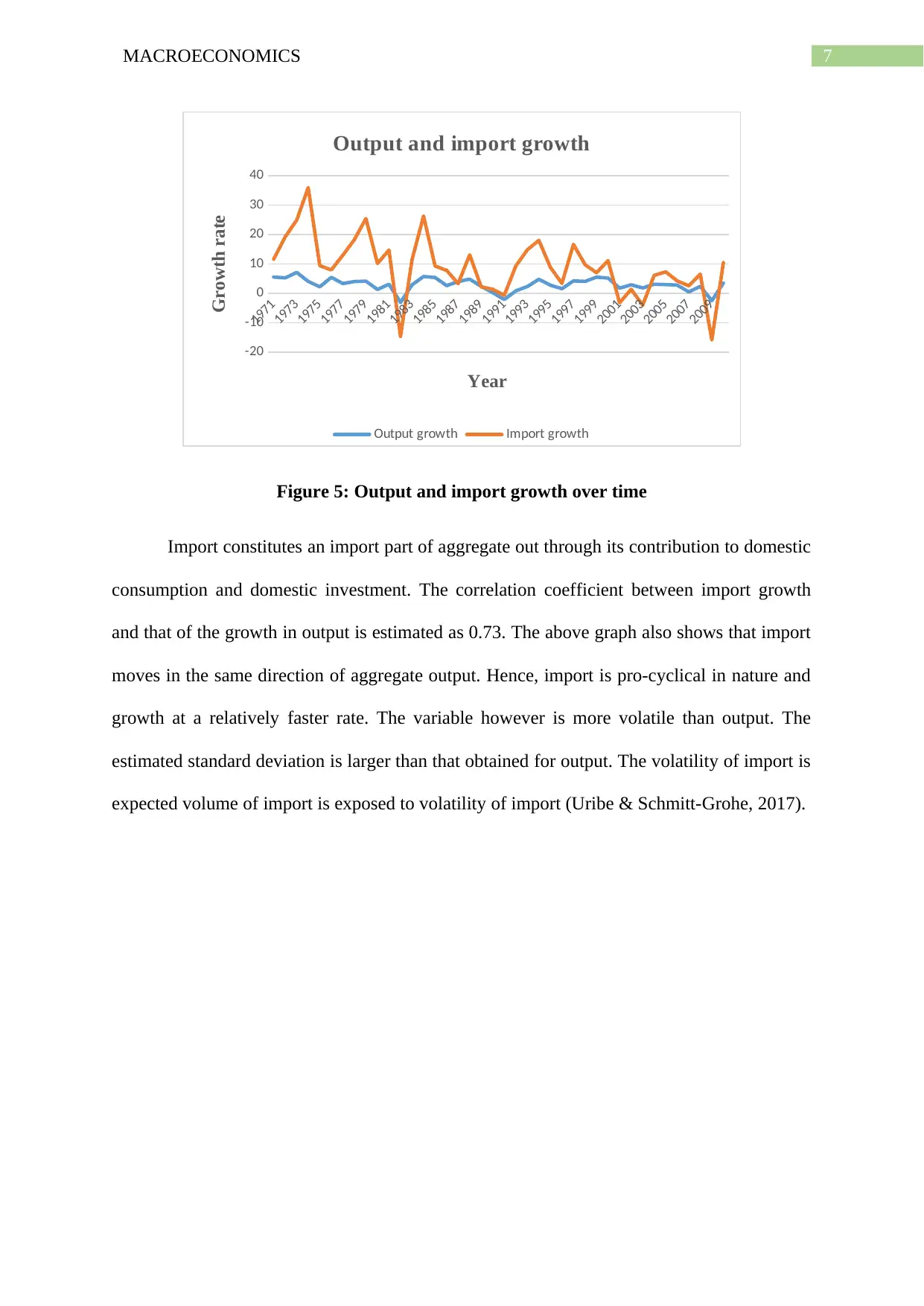
7MACROECONOMICS
1971
1973
1975
1977
1979
1981
1983
1985
1987
1989
1991
1993
1995
1997
1999
2001
2003
2005
2007
2009
-20
-10
0
10
20
30
40
Output and import growth
Output growth Import growth
Year
Growth rate
Figure 5: Output and import growth over time
Import constitutes an import part of aggregate out through its contribution to domestic
consumption and domestic investment. The correlation coefficient between import growth
and that of the growth in output is estimated as 0.73. The above graph also shows that import
moves in the same direction of aggregate output. Hence, import is pro-cyclical in nature and
growth at a relatively faster rate. The variable however is more volatile than output. The
estimated standard deviation is larger than that obtained for output. The volatility of import is
expected volume of import is exposed to volatility of import (Uribe & Schmitt-Grohe, 2017).
1971
1973
1975
1977
1979
1981
1983
1985
1987
1989
1991
1993
1995
1997
1999
2001
2003
2005
2007
2009
-20
-10
0
10
20
30
40
Output and import growth
Output growth Import growth
Year
Growth rate
Figure 5: Output and import growth over time
Import constitutes an import part of aggregate out through its contribution to domestic
consumption and domestic investment. The correlation coefficient between import growth
and that of the growth in output is estimated as 0.73. The above graph also shows that import
moves in the same direction of aggregate output. Hence, import is pro-cyclical in nature and
growth at a relatively faster rate. The variable however is more volatile than output. The
estimated standard deviation is larger than that obtained for output. The volatility of import is
expected volume of import is exposed to volatility of import (Uribe & Schmitt-Grohe, 2017).
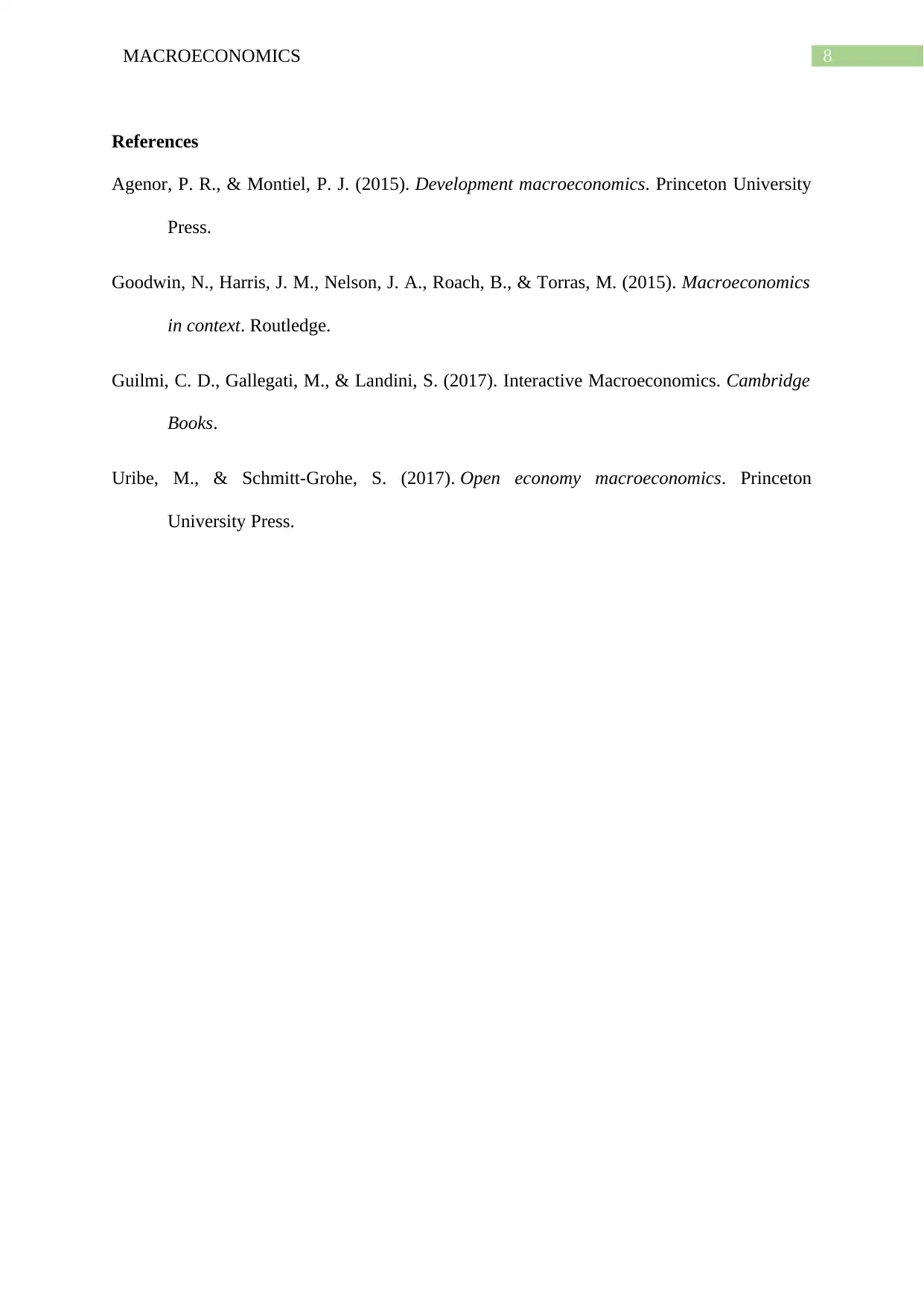
8MACROECONOMICS
References
Agenor, P. R., & Montiel, P. J. (2015). Development macroeconomics. Princeton University
Press.
Goodwin, N., Harris, J. M., Nelson, J. A., Roach, B., & Torras, M. (2015). Macroeconomics
in context. Routledge.
Guilmi, C. D., Gallegati, M., & Landini, S. (2017). Interactive Macroeconomics. Cambridge
Books.
Uribe, M., & Schmitt-Grohe, S. (2017). Open economy macroeconomics. Princeton
University Press.
References
Agenor, P. R., & Montiel, P. J. (2015). Development macroeconomics. Princeton University
Press.
Goodwin, N., Harris, J. M., Nelson, J. A., Roach, B., & Torras, M. (2015). Macroeconomics
in context. Routledge.
Guilmi, C. D., Gallegati, M., & Landini, S. (2017). Interactive Macroeconomics. Cambridge
Books.
Uribe, M., & Schmitt-Grohe, S. (2017). Open economy macroeconomics. Princeton
University Press.
⊘ This is a preview!⊘
Do you want full access?
Subscribe today to unlock all pages.

Trusted by 1+ million students worldwide
1 out of 9
Related Documents
Your All-in-One AI-Powered Toolkit for Academic Success.
+13062052269
info@desklib.com
Available 24*7 on WhatsApp / Email
![[object Object]](/_next/static/media/star-bottom.7253800d.svg)
Unlock your academic potential
Copyright © 2020–2025 A2Z Services. All Rights Reserved. Developed and managed by ZUCOL.





